Author: Bridget Harris Source: substack Translation: Shan Oppa, Golden Finance
< p style="text-align: left;">
The data availability layer has become an important part of the modular architecture, acting as a pluggable component to reduce costs and scale the blockchain. The core function of the DA layer is to ensure that on-chain data is available and accessible to all network participants. Historically, each node had to download all transaction data to verify that the data was available—a highly inefficient and costly task. This is how most blockchains currently work, and is a barrier to scalability, as the amount of data required for verification increases linearly with block size. End users suffer here: data availability costs account for 90% of the transaction costs incurred by users transacting on Rollup (90% of the current cost of Rollup sending transaction data to Ethereum is $1300-1600/MB ).
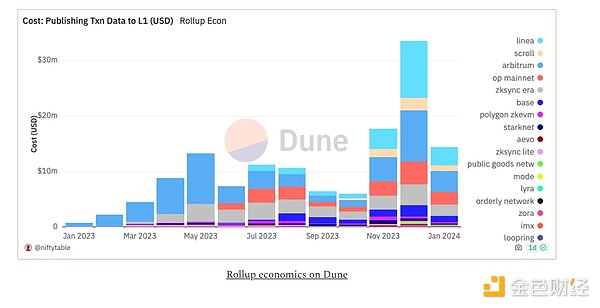
p>
The introduction of Data Availability Sampling (DAS) fundamentally changes this architecture. With DAS, light nodes can confirm that data is available by participating in multiple rounds of random sampling of block data without having to download each entire block. Once multiple rounds of sampling are completed, and a certain confidence threshold that the data is available is reached, the rest of the transaction process can proceed safely. In this way, the chain can expand its block size while maintaining simple data availability verification. Significant cost savings are also achieved: these emerging layers can reduce DA costs by up to 99%.
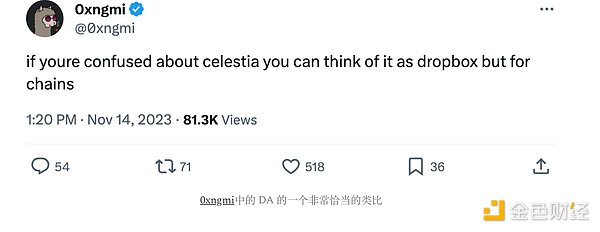
p>
In addition to achieving higher throughput, a data availability layer also makes sense to improve interoperability. Cheap DA will inevitably drive a Cambrian explosion of new custom Rollup chains, making deployment increasingly easier through Rollup-as-a-service providers like Caldera, AltLayer, and Conduit. However, as L2 and L3 ecosystems emerge, they become fragmented by default. Getting users to use new platforms is already difficult—it gets even worse if interoperability, liquidity, and network effects are limited. A unified DA layer as the foundation of each network will make the flow of funds simpler and attract a wider user base.
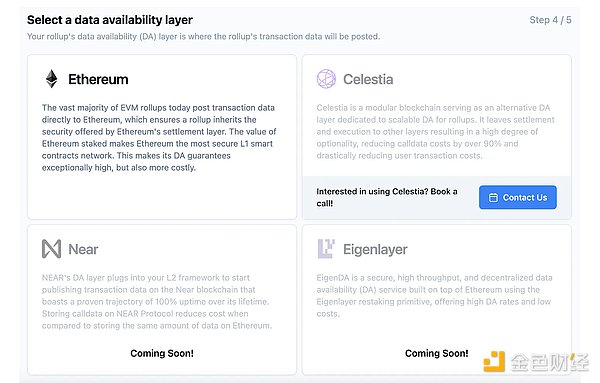
p>
CalderaCaldera and other RaaS providers will enable projects to select a DA layer when building custom Rollups
Avail, EigenDA, EigenDA, and Celestia are the protagonists in the DA ecosystem - each serving the same space, but The approach is slightly different in terms of infrastructure stack, execution and go-to-market.
In terms of technical architecture, Avail, Ethereum and EigenDA use KZG commitments, while Celestia uses fraud proofs to confirm blocks are encoded correctly. Generating KZG proofs—albeit a very rigorous way to prove DA—incurs more computational overhead for block producers, especially as block sizes increase. Celestia, on the other hand, assumes that data is implicitly available through its fraud prevention scheme. In exchange for not completing the computational "work", the system must wait for a fraud proof dispute period before nodes can confirm that the block has been accurately encoded. Both KZG proofs and fraud proofs are undergoing rapid technological advancement; their trade-offs are likely to continue to become more complex, and it is unclear whether one mechanism will be strictly superior to the other.
For Avail, their architecture with KZG commitments makes them a good fit for the zk structure - this is an area where Celestia may face difficulty, because if zk in the future Dominant, they rely on optimism to prove it. Additionally, Avail's light client p2p network can support the network even if all full nodes are down; whereas in Celestia's architecture, light clients cannot function without full nodes. Avail and Celestia both use erasure coding under DAS (distributed storage) to break data into fragments, adding redundancy and allowing data to be reconstructed for verification.

p>
In contrast to Celestia and Avail's stacks, EigenDA leverages Ethereum's existing infrastructure. EigenDA If data needs to be sent to the aggregation contract to prove the data is available, EigenDA inherits the same finalization time as Ethereum. inherits However, if rollup uses EigenLayer entirely, finalization can be achieved faster.

p>
For consensus, Avail uses BABE + GRANDPABABE + GRANDPA and designated proof of stake (NPoS) inherited from the Polkadot SDK. NPoS serves to nominate a set of validators that delegators are willing to elect, while BABE stipulates who will propose the next block, and GRANDPA acts as the block finalization algorithm.
Celestia uses Tendermint as the consensus mechanism, allowing users to stake their TIA to earn validator staking rewards. Although Celestia is able to achieve fast finality through Tendermint, due to its optimistic architecture, there is a waiting period for guarantees of actual data availability (users must have time to submit fraud proofs).
EigenDA itself has no consensus, but has two mechanisms to ensure the effectiveness of data availability:
Proof of custody. This is essentially an economic security mechanism that ensures nodes store data, but does not actually guarantee that data is available to everyone in the network. Nodes will be cut if they do not comply, for example if they cannot prove they own the data.
Full decentralization. Ensuring that the operator set remains decentralized and collusion-proof is critical to the correct functioning of the network. With a large and independent validator set, data services become a competition that many market participants are willing to participate in. Collusion is extremely difficult at this scale.
An interesting point worth mentioning is that Celestia’s active validator set consists of the top 100 validators with the most staked tokens The threshold may be lowered in the future. Additionally, each of their validators stores the entire dataset. EigenDA will optimize for each node storing a small portion of the data (potentially millions in the future), so if enough nodes are honest, the data can be reconstructed. The full origins of EigenDA (and more details) can be found in Sreeram’s recent post.

p>
Finally, Avail provides a useful comparison of the core components of the main DA layer.
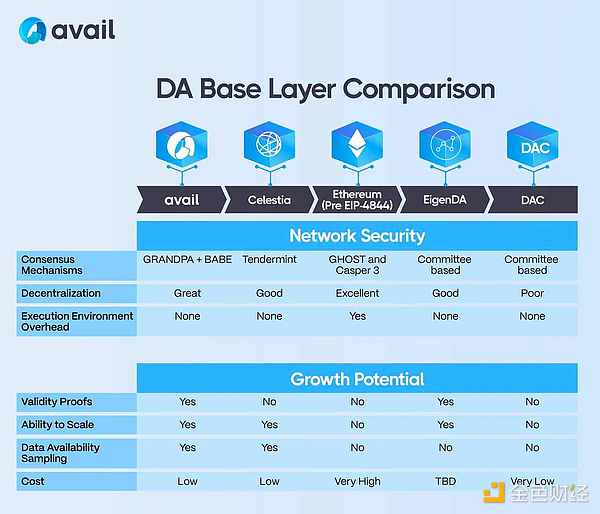
New discussions have also emerged about the trade-offs of each design. David Hoffman pointed out that Celestia is a complete blockchain in itself - a complex stack that requires more than pure DA. EigenDA, on the other hand, is just a set of smart contracts, but it relies on Ethereum, whereas Celestia and Avail do not.
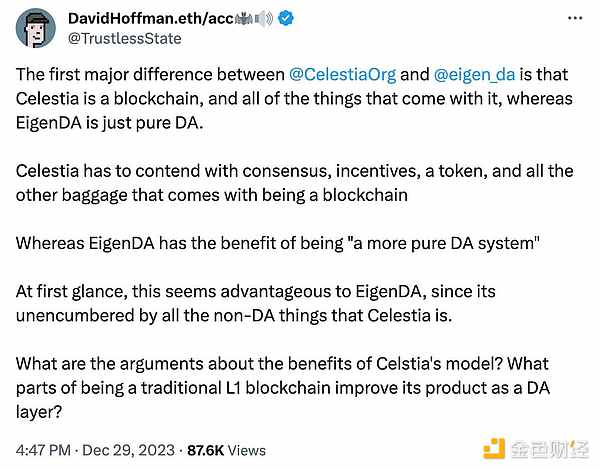
The Celestia team believes that tokens are necessary for security, and that EigenDA will eventually require tokens because it is impossible to cut the availability of on-chain data. They believe that in order to ensure that nodes are honest, data is available and punish malicious nodes, the network must be verifiable through an incentive structure that includes native tokens. Here, Celestia's Nick White raises a criticism of EigenDA: "Revalidators that retain the data will not be slashed unless the source chain is forked - which is highly unlikely since this is Ethereum."< /p>
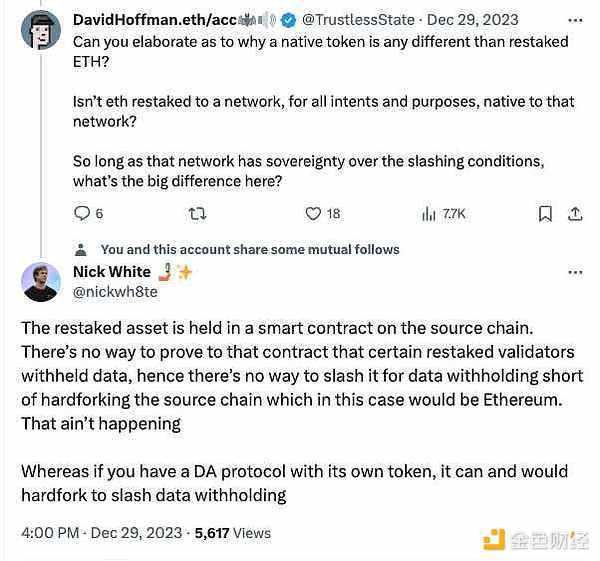
From a brand perspective, EigenDA is a product that is extremely consistent with Ethereum. The EigenLayer team is building upon EIP-4844 and danksharding—EigenDA is being built as, in Sreeram’s words, “the only ETH-centric data availability layer.” He explained that by definition, the Data Availability Layer is a modular product, but the other DA “Layer” is actually the blockchain itself.
Packaging the DA layer into the blockchain does bring obvious benefits to Rollups running natively on it, mainly in the form of security guarantees. However, Sreeram mentioned that his team’s goal in building EigenDA was to create a product that provides data availability services to the Ethereum ecosystem from first principles—a true “layer” adjacent to the Ethereum ecosystem. He noted that there is no need for a separate consensus here, as Ethereum-based Rollup already relies on the network for ordering and consensus. (Sreeram explained this in a recent episode of Bankless.)
Avail is built with proof-of-validity and DAS, allowing for a high degree of flexibility in the ecosystem and interoperability. Their architecture lays the foundation for an extensible framework designed to support services across many different platforms. This “unbiased” stance allows for greater interoperability and capital flows, and also appeals to non-Ethereum-centric ecosystems. The ultimate goal here is to take ordered transaction data from all chains and aggregate it into Avail, making them the coordination center for all web3. To launch the network, Avail recently launched a node clash event alongside its incentivized testnet, allowing users to run validators and light clients and participate in network challenges.
Celestia’s ecosystem consists of RaaS providers, shared sequencers, cross-chain infrastructure, etc., covering the ecosystems of Ethereum, Ethereum rollups, Cosmos and Osmosis. system.
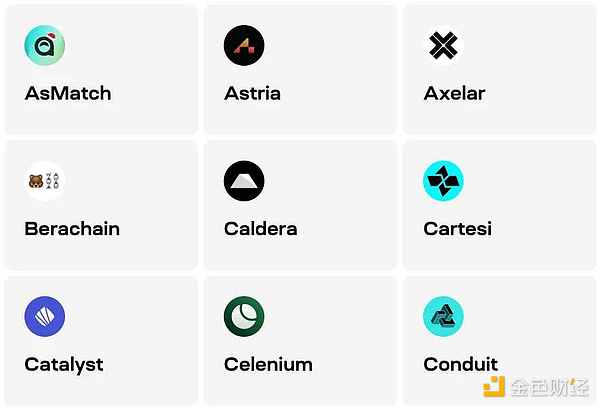
Snapshot of the Celestia Ecosystem Page
these Every design choice, whether technical or marketing, comes with interesting trade-offs. Personally, I'm not sure if the data availability category will be a winner-take-all or commoditized market - instead, there may be an oligopoly-type market where projects choose the DA layer that best suits their needs. Depending on the type of protocol, teams can optimize for interoperability, security, or preference for a certain ecosystem or community. If custom use case aggregation explodes as expected, they won't hesitate to integrate the DA layer - and there will be more than one powerful option to choose from.
The technology - and the modular narrative in general - is still relatively new, with Celestia just recently coming online, Avail and EigenDA set to launch in the coming months Enter the main network. However, the technological advances in modularism so far have been remarkable (many of these concepts were just ideas a few years ago!). By fundamentally improving the way we build and use blockchains, the DA layer will undoubtedly become one of the core technologies of this cycle and beyond.
 JinseFinance
JinseFinance













